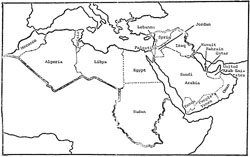|
WHO ARE THE ARABS? The Arabs are not and never have been a single nationality or a single people. This is not to say that they have not had, in their ancient history as well as in the modern day, a nationhood and nations. Indeed, there are today twenty-two Arab nations, stretching from the Atlantic shores of Morocco to the Persian Gulf, from the Mediterranean to the middle of the Sahara and the Upper Nile. The Arab World crosses the continents of Africa and Asia to the tip of Europe and numbers at least one hundred thirty million of the earth's people. What then is "Arab" if it is not a single nationality? The Arab identity, like that of the Jews, is a cultural identity, linking the peoples of the Middle East and North Africa through language, tradition, history, and religion. We might consider those states which are associated with the League of Arab States to be what is recognized as the Arab World. These are organized into four zones, different in geographic and demographic characteristics, but alike in the language and heritage which binds them. One zone is the Arab East, called Al-Mashraq, which means, simply, "East, where the sun rises." This section embraces Syria, Lebanon, Jordan, Iraq and Palestine.1 A second zone contains the countries of the Nile--Egypt
and Sudan. The Arab West, Al-Maghreb, "land of the sunset," can be considered the third zone. This section includes Libya, Tunisia, Algeria, Morocco and Mauretania. The fourth zone, the Gulf States, is comprised of Saudi Arabia, Kuwait, Yemen, people's Yemen, Bahrein, Quatar, Oman, and the United Arab Emirates.
THE ARAB WORLD
|

